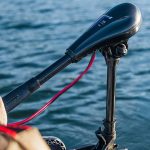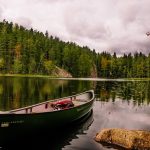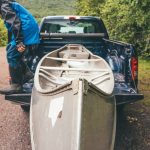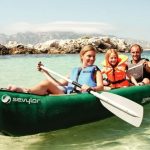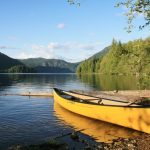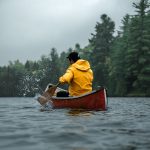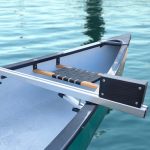If you’re going to head out with a motor on your canoe, a square stern design is your best choice. Such canoes are popular among anglers and duck hunters.
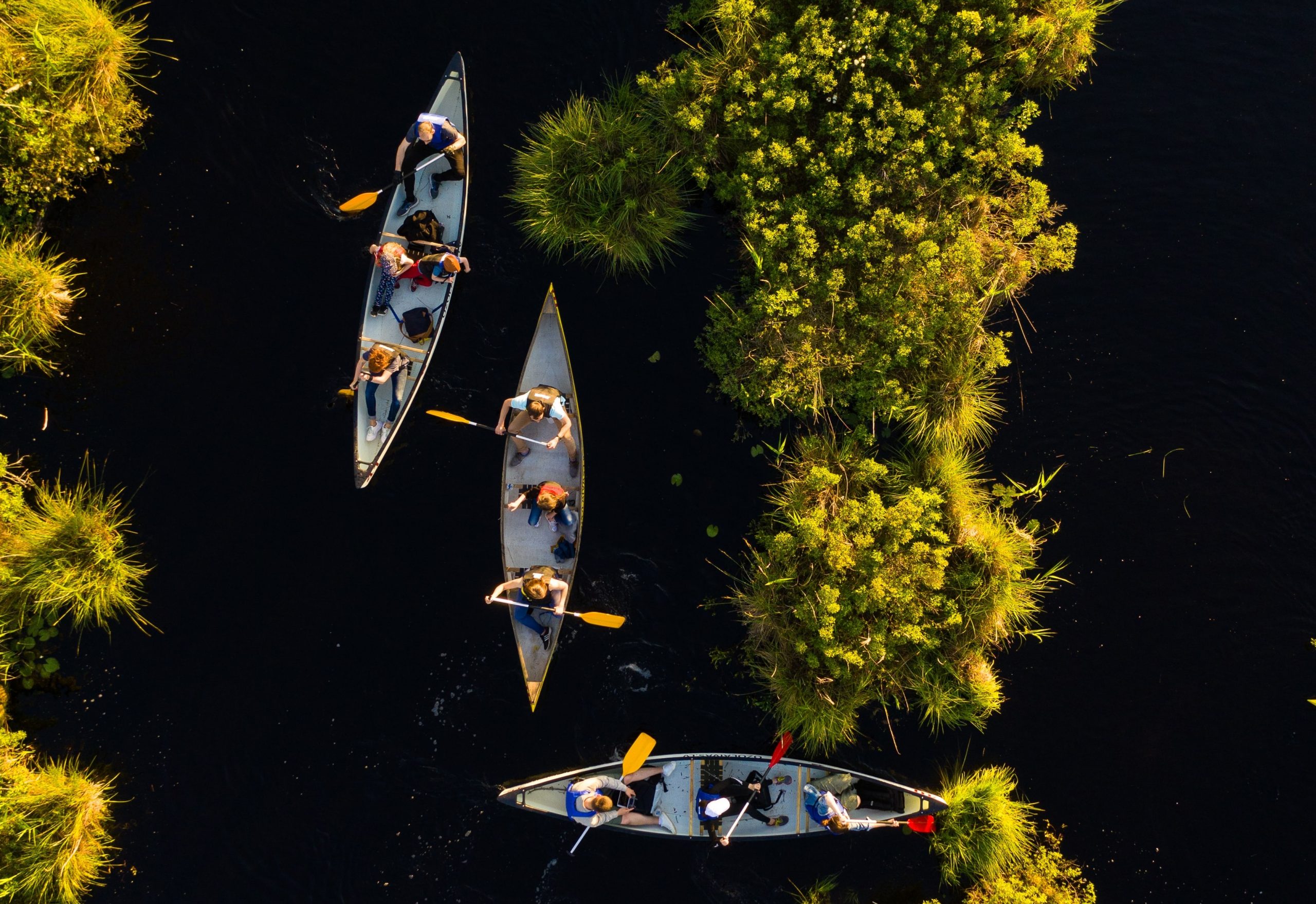
Canoeing with your family is about more than just time on the water. It’s a great way to get back into nature, bond with each other, and introduce your children to the sport. From lazy days floating around on the lake to heading out camping for their first overnight trip, there is no better way to get to the water than with a family canoe.
Our guide to family canoes will help you ensure you buy the right boat to get everyone out for a safe and enjoyable trip so that they keep coming back again and again.
At a Glance: Best Family Canoes
- Best All-Around: Old Town Discovery 169
- Best Recreational: Lifetime Kodiak
- Best Budget: Mad River Canoe Adventure 14
- Best for Fishing: Old Town Saranac
- Best Aluminum: Grumman 17’ Double-End
- Best Inflatable: Sea Eagle TC16
- Best for Motor Mounting: Sun Dolphin Mackinaw SS
Comparison Table: Best Family Canoes
| Model | Specs | Where to Buy |
 Old Town Discovery 169 | Size: 16’9” x 37″ Weight: 91 lbs. Capacity: 1400 lbs. | Old Town Canoe |
 Lifetime Kodiak | Size: 13′ x 39″ Weight: 96 lbs. Capacity: 600 lbs. | Amazon |
 Mad River Canoe Adventure 14 | Size: 14′ x 33″ Weight: 75 lbs. Capacity: 875 lbs. | Mad River Canoe |
 Old Town Saranac | Size: 16′ x 37″ Weight: 89 lbs. Capacity: 850 lbs. | Dick’s Sporting Goods |
Grumman 17’ Double-End | Size: 17′ x 36″ Weight: 75 lbs. Capacity: 755 lbs. | Amazon |
 Sea Eagle TC16 | Size: 16′ x 38″ Weight: 64 lbs. Capacity: 915 lbs. | Amazon |
 Sun Dolphin Mackinaw SS | Size: 15’6″ x 42″ Weight: 104 lbs. Capacity: 800 lbs. | Amazon |
Top 3 Person Canoes Reviewed
Best All-Around: Old Town Discovery 169
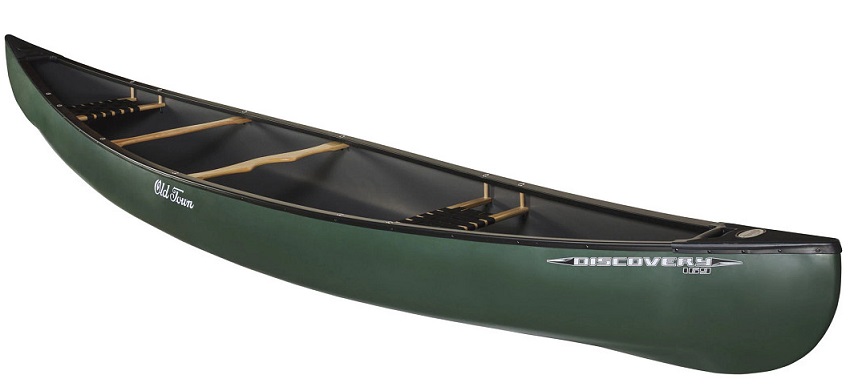
Length: 16 ft. 9 in. (5.1 m)
Width: 37 in. (94 cm)
Weight: 91 lbs. (41.2 kg)
Capacity: 1400 lbs. (635 kg)
Material: Three Layer Polyethylene
It’s not for nothing that Old Town is the world’s oldest manufacturer of canoes. The Discovery series is one of the most recognizable canoes on the market, suited to recreation, tripping, and low-grade whitewater rivers. Although the Discovery 169 only has two fitted seats, Old Town Canoes sells a snap-in center canoe seat that can provide a third seat when you need it.
The Discovery 169 is the largest of the Discovery range, with a huge capacity of 1400 lbs. Even fully loaded with the kids, the dog, and all of your camping gear, you’ll be able to paddle this canoe easily and efficiently across great distances. It’s stable, too, and at 37 inches wide you’ll have a hard time capsizing.
Pros:
- Highly stable and family-friendly
- Long and covers the water easily
- One of the most established canoes on the market
- High capacity
Cons:
- Heavy
- Only two fitted seats
Best Recreational: Lifetime Kodiak
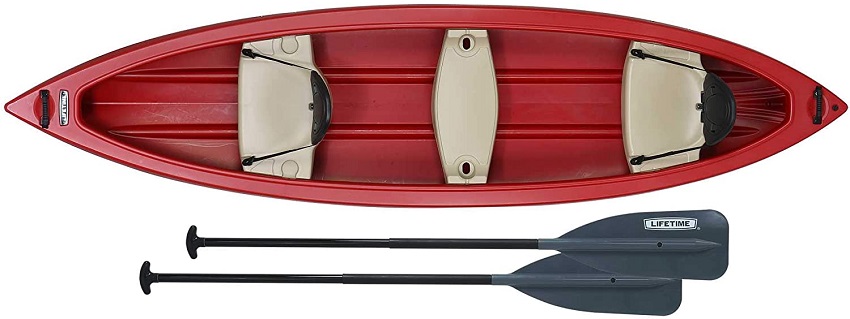
Length: 13 ft. (3.9 m)
Width: 39 in. (99 cm)
Weight: 96 lbs. (43.5 kg)
Capacity: 600 lbs. (272 kg)
Material: High-Density Polyethylene
The robust simplicity of the Lifetime Kodiak makes it a hit with families. This recreational canoe is one of the widest on the list, making it a stable platform for exploring the water or relaxing in the sun. The shorter stature of the Kodiak does limit its top speed though, and you won’t want to be planning any long journeys, though the v-shaped bow and skeg do help it hold a course.
The three fitted seats are all comfortable enough to keep you out on the water, with the bow and stern seats also fitted with adjustable backrests. The main selling point of the Lifetime Kodiak is just how strong it is, capable of withstanding the rough use that family life throws at a canoe. This doesn’t come without excess weight though, and at 96 lbs., this is one of the heaviest canoes on our list.
Pros:
- Wide and stable for family use
- Substantial and ready to withstand years of use
- Easy to paddle with a v-shaped bow and rear skeg
Cons:
- Heavy
- Relatively low capacity
Best Budget: Mad River Canoe Adventure 14
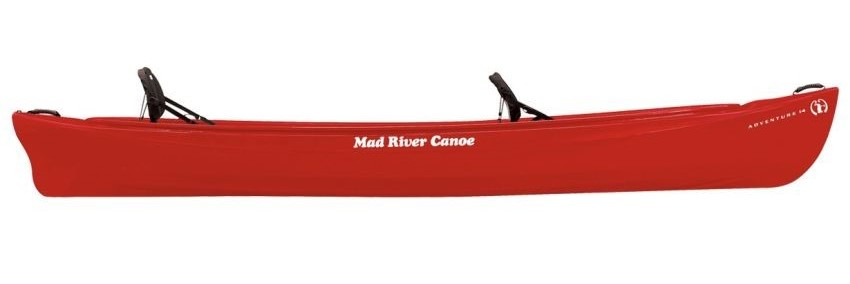
Length: 14 ft. (4.27 m)
Width: 33 in. (84 cm)
Weight: 75 lbs. (34 kg)
Capacity: 875 lbs. (397 kg)
Material: Polyethylene
The Mad River Canoe Adventure 14 is proof that you don’t have to break the bank to get a great family-friendly canoe. The 14-foot length of this canoe balances transportation and storage against the ability to cover reasonable distances without overworking yourself. The Adventure 14 is the narrowest canoe on our list, but it’s stable enough to inspire confidence on the water.
The bow of Adventure 14 is slightly raised, to run higher and drier through waves on open water or on rivers. At the stern, Mad River Canoes has elongated the keel line slightly to increase the waterline and enhance the straight line speed of this canoe. The bow and stern seats are fitted with high backrests and seat pads for extra comfort, while the middle seat features a molded design for easy access.
Pros:
- Affordable
- Good balance of length and portability
- Versatile for a range of environments
Cons:
- Narrow and less stable than other canoes on this list
Best for Fishing: Old Town Saranac
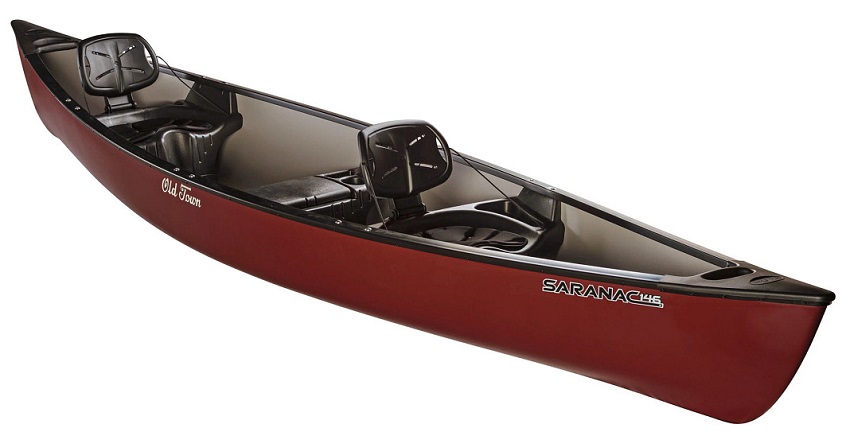
Length: 16 ft. (4.87 m)
Width: 37 in. (94 cm)
Weight: 89 lbs. (40 kg)
Capacity: 850 lbs. (385 kg)
Material: Thermoformed Polyethylene
The Old Town Saranac is a family-friendly canoe that is fishing-ready. If you’re a keen angler that wants to get the family out on the water, the Saranac will prevent you from having to buy a second boat. It’s basically a 2-in-1, ready to go wherever you want to take it.
This is an easy-to-paddle, beginner-friendly canoe, with a wide beam making it suitable for standing and moving around. The molded bow and stern seats are fitted with pads and backrests, for long days on the water. The central seat is fitted with rod holders, as well as storage facilities for on-the-water equipment, whether it’s tackle boxes or children’s toys.
Pros:
- Versatile fishing-ready canoe
- Affordable
- Sturdy
- Reasonable capacity
Cons:
- Heavy
Best Aluminum: Grumman 17’ Double-End

Length: 17 ft. (5.18 m)
Width: 36 in. (91 cm)
Weight: 75 lbs. (34 kg)
Capacity: 755 lbs. (342.5 kg)
Material: Aluminum
The Grumman 17’ Double-End canoe is the flagship of the aluminum canoe industry. Aluminum canoes are the sturdiest on the market, easy to repair, and will be in the family long enough that you’ll probably be able to take the grandkids out in them. Even better, you don’t need to worry about storage, aluminum canoes are able to withstand all types of weather as well as UV damage.
The Grumman 17’ Double-End is easy to paddle, suited to beginners and young paddlers when they want to start taking themselves for a paddle. These canoes can be used in almost any environment. They are primarily recreational but are also suitable for tripping and white water rivers.
Pros:
- These canoes will outlast any others on this list
- Versatile design
- Easy to repair
Cons:
- Aluminum gets cold in the winter
- Noisy when paddles are bashed against it
Best Inflatable: Sea Eagle TC16
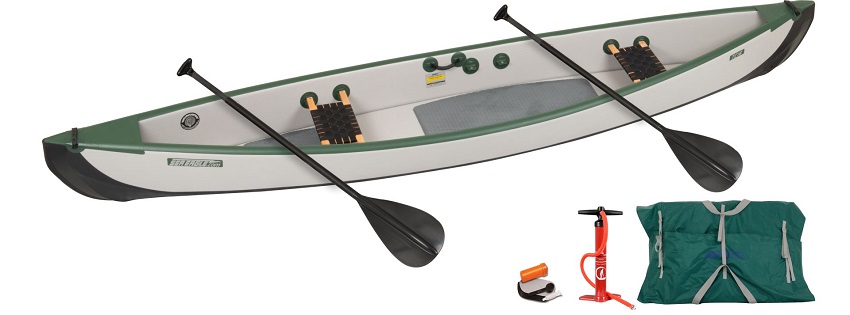
Length: 16 ft. (4.88 m)
Width: 38 in. (97 cm)
Weight: 64 lbs. (29 kg)
Capacity: 915 lbs. (415 kg)
Material: 1000 Decitex Reinforced
When storage space is limited, you need a canoe that isn’t going to take up excess room in your house. The Sea Eagle TC16 deflates and folds up to fit in the trunk of your car, or the cupboard at home. Once you reach the water, the TC16 inflates in just ten minutes, ready to take you out on your journey.
Drop stitch technology allows the TC16 to be inflated to high pressure, making it feel and paddle like a hard-shelled canoe. The plastic bow and stern, as well as the long skeg, give the TC16 a reasonable level of tracking, but inflatable canoes are susceptible to being blown about by the wind. The seats are removable, and you can have anywhere from one to three seats fitted at any time.
Pros:
- Easy to transport and store
- Quick to inflate
- Moveable seats
- Easy to paddle, stable design
Cons:
- Affected by the wind
- Expensive
Best for Motor Mounting: Sun Dolphin Mackinaw SS

Length: 15 ft. 6 in. (4.72 m)
Width: 42 in. (107 cm)
Weight: 104 lbs. (47 kg)
Capacity: 800 lbs. (363 kg)
Material: High-Density Polyethylene
The Sun Dolphin Mackinaw SS is a three-person, family-friendly canoe that has a built-in transom on the rear, ready to take a trolling motor. Trolling motors are generally favored by anglers but can be used to help take your family further, more easily. The Mackinaw SS is a fully recreational canoe, fitted out for shorter trips on calm water.
The three seats are all basic but molded for comfort on the water. The central seat is fitted with a cooler, perfect for on-the-water beverages or snacks on hot days. The Mackinaw SS’s HDPE build makes it a durable recreational choice that will have the whole family out on the water.
Pros:
- Wide and stable design
- Motor ready
- Sturdy design
- Central cooler
Cons:
- Basic recreational design
- Heavy
Buying a Canoe for the Family: Things to Consider
Canoes come in different shapes, sizes, and styles. Your perfect family canoe should tick all the boxes for your needs to help you get out on the water safely and have a great time canoeing.
Stability
Family canoes are often the first step onto the water for children. But it’s also often the case that parents are heading out on the water, having not canoed since that one time at summer camp twenty or more years ago. A stable canoe will inspire confidence on the water and allow you to explore further from the shore.
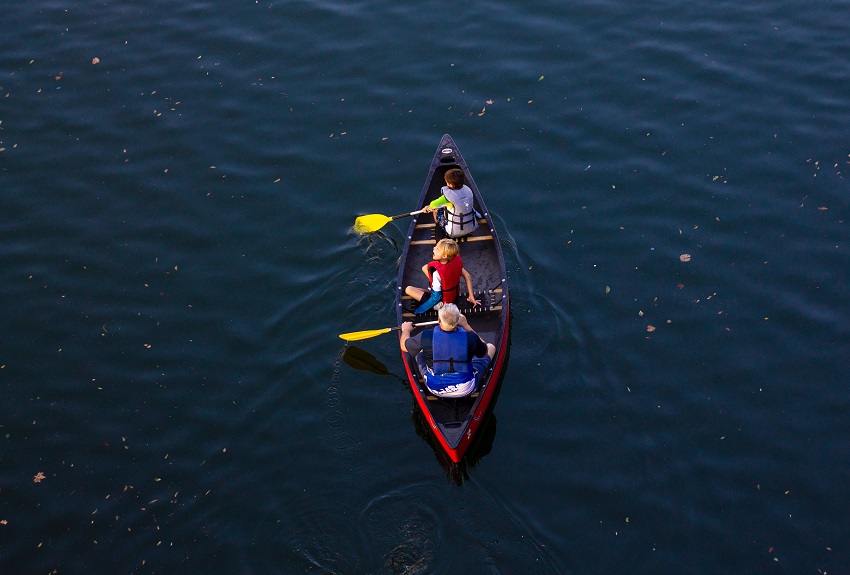
Wide canoes tend to be the most stable, with flatter hulled boats having the most primary stability. This means your canoe will be more stable when it’s flat and not moving, often better for children who like to move around the canoe or use it as a diving platform.
Speed
A reasonable top speed is an essential feature to look for if you plan to canoe more than a few miles at a time. Slower canoes will drag through the water and not only be exhausting, but demoralizing, especially for younger paddlers.
Longer, narrower canoes are faster, with wide canoes generating greater levels of drag. This can be an issue if you want a stable and fast canoe, but there are compromises you can make and a sweet spot to be struck. These longer canoes also track more effectively against the wind, making it easier to hold the course in waves and swell.
The longer the canoe, the harder it is to turn in a tight spot. These boats might be great for long open-water trips, but if you want to navigate narrow rivers or white water rapids, a shorter more maneuverable canoe is a better family option.
Size and Weight
Most canoes are somewhere between 13 – 17 feet long. As we said before, this length will impact how fast and maneuverable you can be on the water. But there are more issues to consider with regards to the size.
The depth of your canoe is also important. The deeper your canoe, the harder it will be for smaller arms to reach over the edge and paddle effectively. If you want your children to take part, consider a lower sided canoe. However, be aware that these lower canoes are more prone to splashes and waves coming onboard if you paddle in rough conditions or on rivers.
The bigger your canoe, the more space you will need for storage and the more difficult it might be to transport. When you get to the lake, you need to be able to move your canoe from the roof of your car to the water’s edge. This isn’t always easy with children in tow and all the equipment, and often a trolley is one of the best additional purchases you can make.
Seating
It’s generally a good idea to make sure that every paddler has a seat to sit on. This doesn’t just make their time on the water more comfortable. It allows them to participate in paddling, stay engaged, and grow a love for the sport.
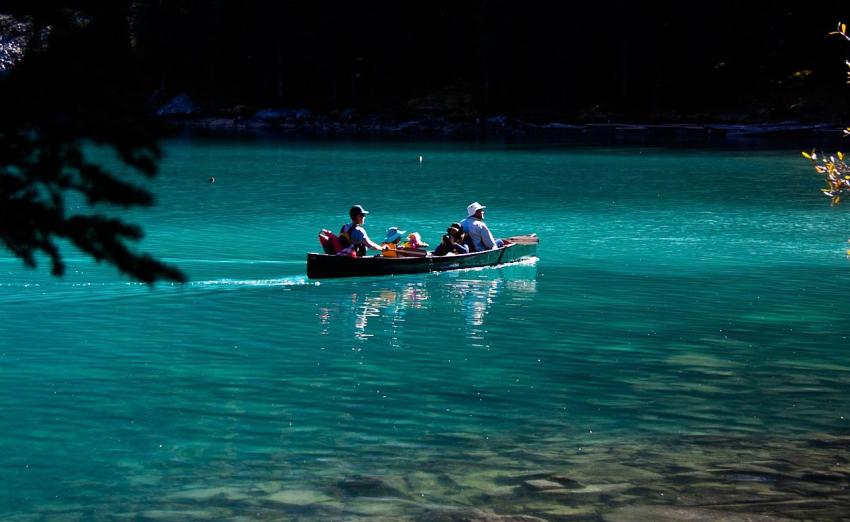
Small children can often share a seat and some families will put two children in a front seat, with an adult in the rear seat. Alternatively, a three-seat canoe can provide space for adults and children at the same time. As your young paddlers grow, you may find that you need a second canoe to keep them fully engaged.
Capacity
Canoes are tested to an upper capacity. This is the weight they can carry and still remain afloat. But to remain within optimal performance for a canoe, you should never overload 70% of this capacity. For example, a canoe with a capacity of 1000 lbs. should never be loaded to more than 700 lbs.
Your paddling weight includes all the paddlers, the gear they are wearing, and all the extra equipment you’re taking on the water with you. When you work out your collective paddler weight, remember that there’s a good chance your children are going to grow in the next few years.
Material
You want your family canoe to be as durable as possible, but ideally not to weigh so much that you can’t all move it together. Most canoes now are made from rotomolded plastics, which are durable, cheap, and last a long time.
Alternatively, you can get composite canoes, made with fiberglass or carbon elements. These are lightweight and some of the best canoes on the market to paddle, but also command a far higher price tag.
Aluminum canoes are still popular, like the ones you may have paddled at summer camp when you were younger. These are strong and don’t require any special storage, but can be noisy and are often less comfortable than plastic or composite canoes.
How often will you go canoeing?
This is an important question to consider before you commit to spending too much money on a canoe. Are you likely to become avid canoeists, or is this going to be a part-time hobby for the occasional summer’s day?
If you’re not sure how your children will take to canoeing, you can always rent or borrow a canoe for a day before you buy one. That way, you will have an idea of whether they’re going to be keen to get out on the water. You want the best canoe for the job, but there’s no use buying a state-of-the-art canoe to hang from the roof of your garage all year.
Future Proof Your Purchase
As we said before, children are going to grow. Your family might get bigger, too. Are you going to have another child, or perhaps get yourself a furry friend that you want to take canoeing? Think to the future and make sure your chosen canoe won’t become useless in a couple of years’ time.
Staying Safe on the Water

Wear your PFD
Keeping everyone safe should always be a number one priority, whether you’re seasoned canoeists or novice paddlers. Every person going out on the water should wear a properly fitted, appropriate PFD. These come in all shapes and styles, including youth and infant. The right style is especially important for younger paddlers who may struggle to keep themselves face up in the water otherwise.
Acclimatize
Before you head out on the water for the first time, it’s a good idea to practice floating in your new PFD. That way, an accidental capsize won’t be the first time your child has to experience floating in deep water. A short practice session can encourage water confidence and stop them from panicking if they fall in.
Make a Capsize Plan
Have a capsize plan, just in case you do end up in the water. This could include knowing how to empty and reenter the canoe, as well as making a plan to keep track of people and pets.
Don’t Tie Anyone Down
Don’t be tempted to tether anyone to your canoe, no matter how young or furry they are. Tethered participants cannot escape a canoe and will be dragged around and potentially underwater after a capsize in strong currents or wind.
Getting a Swimmer back Onboard
If anyone does end up in the water, either through falling in or jumping in for a swim, climbing back onboard can be hard work. PFD shoulder straps are an easy way to haul a swimmer back into the canoe. Counterbalance yourself against their weight, bend down, and haul them back onboard with their help. If you’re feeling malicious, give them a brief dunking on the way down.
Paddling Together
Trim
Positioning people correctly in the canoe will make it much easier to control your canoe. The forward to backward balance of your canoe, otherwise known as trim, is affected by where you position different people. In general, you want slightly more weight towards the back of your canoe than at the front.
In a canoe with three seats, position the younger paddlers centrally so they balance the canoe and you can reach them easily. If you are paddling with one adult and one child in each canoe, the adult will find it easier to control the boat and keep an eye on the child if they sit at the rear.
Getting Moving
Try to have an even number of paddlers on either side of the canoe. If you are an odd number, make sure the adults are on opposite sides, with the younger members helping whichever adult produces less power with their stroke.
Paddling in time with each other can help to generate a rhythm and keep the boat moving smoothly on the water. You can encourage children to count or chant to help keep this rhythm and it keeps them involved, even if they are struggling with paddling itself.


